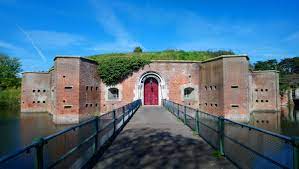2 May 2024
Rearmament
More like the 1860’s than the 1930’s?
By Neil Tidmarsh.

“The Russians are coming. Today Ukraine, tomorrow Poland, Germany, France, Britain… Putin has put his country on war-footing and he’s heading this way, driven by megalomania, paranoia, ambition and resentment. And we’re not ready for him. We must rearm. It’s just like the 1930’s, Hitler and Nazi Germany catching the rest of Europe with its pants down. Yes, it’s definitely a ‘30’s moment…”
Or is it? Perhaps it isn’t a ‘30s moment but a ‘60s moment. An 1860’s moment.
Back in 1860, the British press, politicians and numerous other Cassandras were busy shouting “The French are coming! Today Russia, tomorrow Italy, Austria, Britain… Napoleon III has put his country on war-footing and he’s heading this way, driven by megalomania, paranoia, ambition and resentment. And we’re not ready for him. We must rearm. It’s just like the 1790’s, his uncle Napoleon I and revolutionary France catching the rest of Europe with its pants down. Yes, it’s definitely a 90’s moment…”
Napoleon III’s transformation of France into a military dictatorship in the 1850’s had plunged the rest of Europe into a state of deep anxiety. Following the revolution of 1848 which unseated King Louis-Philipe and sent him scuttling into exile in England, Louis-Napoleon had opportunistically travelled in the other direction, from exile in England to a now republican France, and got himself elected its President. Three years later he launched a military coup and abolished the Republic. A year after that he had himself crowned Emperor Napoleon III and declared himself head of a new French Empire.
The new regime had every appearance of being militaristic, aggressive and expansionist. Napoleon III went to war against Russia in 1854, defeating them in the Crimea. In 1859 he went to war against Austria, defeating them in Italy. And then he appeared to set his sights on the Channel and on England. The port of Cherbourg was fortified and enlarged; new wharves were built, presumably to accommodate troop-carrying paddle steamers, and a huge new fortress, La Roule, was constructed. A new rail link to and from Paris was opened. The French navy undertook a massive ship-building program; its new iron-clad ships armed with rifled long-range artillery threatened England’s control of the Channel and even its global maritime supremacy.
An invasion scare swept Britain. “It is against England alone that it is constructed” warned The Times. “Any blow that may be launched from Cherbourg will be short, it will be straight, deadly and decisive, aimed at England’s very heart”. Rumours of impending war rolled to and fro. The French were digging a tunnel under the Channel, they were preparing a fleet of hot air balloons to sail over the Channel… War with France was accepted as imminent and inevitable, and the whole country – press, politicians and populace, with very few exceptions – called for rearmament.
Palmerston’s government heeded that call and undertook a massive and thorough programme of building new defences along the south coast and of reorganising and re-equipping the army and navy. New taxes were raised to cover the staggering £9,000,000 cost (putting paid to chancellor Gladstone’s plans to abolish income-tax). Dozens of mighty, state-of-the-art fortresses were built to defend Portsmouth, Plymouth, Milford Haven, the Isle of Wight, the Solent and the Thames Estuary.
More iron-clad, steam-driven ships equipped with Armstrong’s rifled and breech-loading guns were built to replace the last of the navy’s wooden sailing ships. A revolutionary and unique new battle-ship – HMS Warrior – not merely iron-clad but made completely of iron, was commissioned and would ensure Britain’s naval supremacy for the next decade.
Terms and conditions of service in the army and the navy were improved (flogging was abolished and living space, food and education were improved – illiteracy within the army disappeared earlier than among the civilian population). The Army Reserve and the Royal Naval Volunteer Reserve were created. Militia groups, yeomanry regiments and the many volunteer rifle units which had sprung up as an enthusiastic grass-roots response to the threat of invasion, were integrated into the professional army. The purchase of commissions was abolished and officer training made more professional via Sandhust and Staff College. The Commander-in-Chief and his staff moved from their traditional home in Horse Guards to the army’s current headquarters at the War Office in Pall Mall, reflecting their new status as no longer a rival authority to the government and answerable only to the sovereign but now subordinate to it.
A thorough and prompt rearmament and reorganisation indeed.
But of course that invasion never came. There was no war. A decade or two later, once it became clear that the invasion scare had been unfounded, the expensive rush to rearmament was dismissed as unnecessary, a waste of resources; all those new forts were dubbed ‘Palmerston’s Follies’.
It’s possible that Palmerston’s efforts proved to be an effective deterrent, but it’s more likely that Napoleon III never intended to go to war against Britain in the first place. And it’s highly unlikely that he could have pulled off an invasion even if he’d wanted to, and even if Britain hadn’t prepared for it.
First of all, his efforts in the late 1850’s and early 1860’s were focused on southern Europe, on weakening the Austrian empire by helping to liberate its Italian possessions, and on France’s colonial war in Algeria which had been dragging on for decades.
Second, his forces were over-committed and over-stretched already: even after their victories in the cause of liberation and unification, French troops remained bogged down in Italy defending the Pope and Rome against those same forces of liberation and unification (a mystifying contradiction typical of Napoleon III); other troops were still bogged down in Algeria; and in the early 1860’s he found himself fighting wars outside Europe as well, in China and in Mexico.
Third, even though the French army was considered to be the most powerful in Europe and was feared as such by its neighbours, each of these conflicts revealed it to be rather less formidable than its reputation suggested: its victories over the Russians in the Crimea were limited and extremely hard won, after a grinding and long drawn out war of attrition; its victories over the Austrians in Italy were equally limited and hard won, if swift and intensely bloody (the battle of Magenta was so bloody on both sides that it gave its name to the colour of a new synthetic deep-crimson die, and the battle of Solferino was so devastating to both sides that a Swiss observer was inspired to found the International Red Cross) and Napoleon was so eager to disentangle himself from the conflict that he agreed a premature peace settlement with Austria without even telling his Italian allies; in Mexico, his troops were run ragged by the revolutionaries for most of the decade before being forced to make an ignominious retreat from American soil; and ultimate humiliation came at the end of the decade with the Franco-Prussian war of 1870, which finally revealed the hollowness of Napoleon’s power and put an end to it.
This column has been drawing parallels between Napoleon III and Vladimir Putin for years (ever since the founding of Shaw Sheet in the dim and distant past, in fact) and most of the points made above about France and its emperor in the 1860’s could well apply to Russia and its president in the here and now. Putin’s forces are equally over-stretched and over-committed, bogged down in Ukraine and also in Libya, Africa, the Middle East and elsewhere, and proving themselves to be considerably less formidable than was feared only a few years ago. The tragic farce of his invasion of Ukraine has more in common with Napoleon III’s absurd Mexican adventure in the 1860’s than with Hitler’s occupation of Czechoslovakia and invasion of Belgium in 1939.
So let’s not over-exaggerate the Russian threat. Yes, of course, a government’s first duty is to ensure that its country can defend itself. Yes, Britain’s pledge to increase defence spending to 2.5% or 3% or even more is to be applauded (after all, Russia isn’t the only threat out there). Yes, Europe should step up and pay its fair share towards its own defence and not irresponsibly and selfishly expect the USA to carry most of that burden by itself. Yes, the free West must do everything it can to help Ukraine fight for freedom against the invading dictator. Yes, Nato should make sure that it’s capable of defending its members and allies in Eastern Europe where the Russian threat is very real. And yes, it’s true that Britain must reorganise and rearm after ignoring defence needs for the last two or three decades, irrespective of whether there’s a real and imminent threat or not, just as rearmament and reorganisation was in fact necessary in the 1860’s, because Britain had been ignoring defence needs since the peace of 1815, irrespective of whether Napoleon III’s threat was real or not.
But let’s keep a sense of proportion here. An army which is finding it so difficult to take Kiev would surely find it impossible to take Warsaw or Berlin or Paris. The idea that Russia, even if it does eventually manage to overcome Ukraine, would be in any fit state to then launch a blitzkrieg across the rest of Europe is surely irresponsible scare-mongering. As that old soldier Lance Corporal Jack Jones would say, “Don’t panic!”


